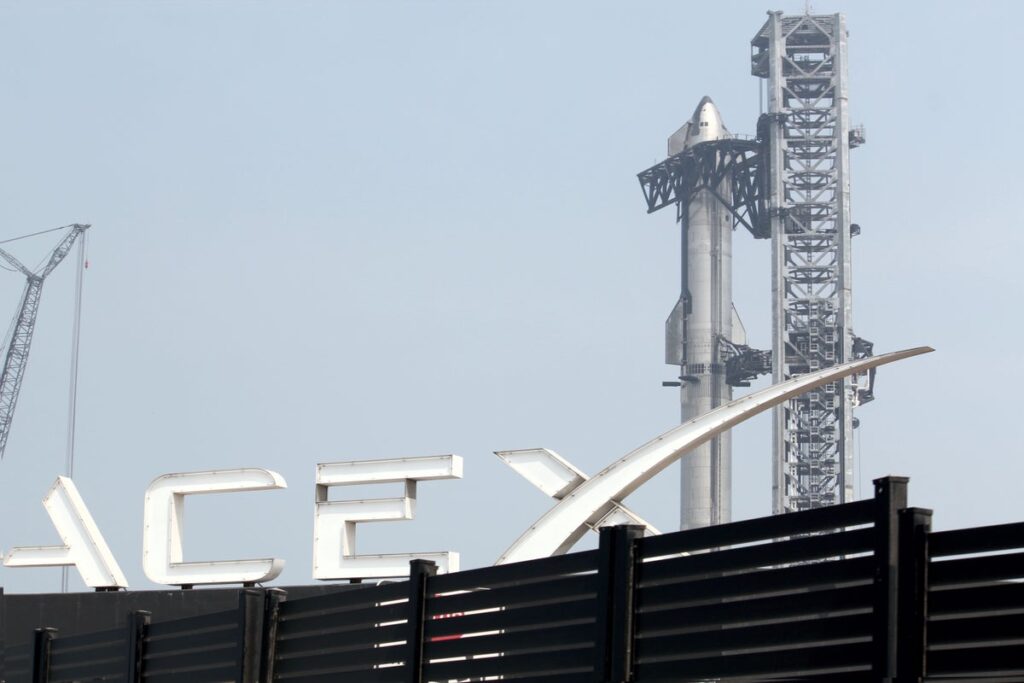October 12, 2025
3 min read
SpaceX’s Starship Succeeds in Final Test Flight of 2025
With the successful eleventh test flight of its Starship megarocket, SpaceX is on the cusp of a new era in spaceflight
A Starship rocket looms behind a SpaceX sign at the company’s Starbase launch facility in South Texas.
Markel Lee Simmons/Getty Images
SpaceX has pulled off another successful test flight of Starship, the world’s largest and most powerful rocket.
This was the eleventh test flight for Starship, which is meant to be the first-ever fully reusable spaceflight system in history, consisting of a Super Heavy first-stage booster and an upper-stage ship that can carry cargo or even crew. It was also the program’s last test flight in a problem-plagued 2025: Prior to the successful 10th flight on August 26, Starship had suffered explosive failures in three back-to-back test flights this year. These and other setbacks had raised concerns about Starship’s technical feasibility—and about the wisdom of NASA in making the in-development rocket a linchpin of its down-to-the-wire plans for returning astronauts to the moon.
Launching at 6:23 P.M. CDT from SpaceX’s Starbase site in South Texas on the combined nearly 17 million pounds of thrust from 33 Raptor engines, Flight 11 aimed to mostly replicate the feats of Flight 10. After throwing the ship on a long suborbital trajectory, the booster would somersault and fire some of its engines to steer itself back to a splashdown in the Gulf of Mexico. Meanwhile, the ship would continue its ascent to test the deployment of several dummy spacecraft for SpaceX’s Starlink global satellite internet service, relight one of its six Raptor engines in space, and finally attempt atmospheric reentry followed by a gentle, powered splashdown in the Indian Ocean. Flight 11 delivered on these objectives with flying colors, achieving its objectives flawlessly with the booster splashing down about 6.5 minutes after launch and the ship doing the same on the other side of the world about an hour later.
On supporting science journalism
If you’re enjoying this article, consider supporting our award-winning journalism by subscribing. By purchasing a subscription you are helping to ensure the future of impactful stories about the discoveries and ideas shaping our world today.
One important difference in this latest test was the ship’s heat shield, which featured multiple patches of subtly reconfigured protective tiles, including some deliberately missing, to test Starship’s tolerance to shedding tiles during flight. Unlike the tiles of Flight 10, most of the thousands covering the ship’s exterior during Flight 11 had also been nestled in a lining of heat-resistant felt—nicknamed “crunch wrap”—to enhance their performance. During Flight 11’s official livestream, SpaceX’s commentators noted that the missing tiles had been removed in “some of the spots that see the highest level of heating” on Starship, to push the vehicle to its limits in enduring the extreme heat of atmospheric reentry.
Another difference was in the booster’s carefully choreographed return from space, which in recent flights had involved firing 13 of its 33 Raptor engines; this time, the booster’s return began with a burn of 13 engines before dwindling to five, and then to three—a dress rehearsal of sorts for the landing maneuvers of SpaceX’s next-generation Starship booster, which is slated to begin test flights next year alongside a new version of the ship, both augmented with improved Raptor engines. Outside of its maneuvers, Flight 11’s booster was also notable itself, as this was its second trip to space after previously flying in Starship Flight 8 in March; for Starship to be successful, its hardware will have to be reused again and again, but at a much higher cadence than the more than half-year that separated this booster’s two spaceflights.
With another successful suborbital test flight on the books, SpaceX is now closer than ever before to what could be a revolutionary new era of space science and exploration. From here, the company will now prioritize planning for further test flights of the next-generation Starship hardware which are set to begin next year. If an initial suborbital flight of this “Block 3” version is successful, the following flight may well see a Starship at last reach orbit. This would be a critical milestone for the program, allowing Starship to not only deliver real spacecraft to bolster the Starlink satellite mega constellation but also to demonstrate the rendezvous and refueling maneuvers that are required for NASA’s Artemis III crewed lunar landing mission, slated for 2027, as well as for SpaceX’s lofty aspirations for human voyages to Mars.
It’s Time to Stand Up for Science
If you enjoyed this article, I’d like to ask for your support. Scientific American has served as an advocate for science and industry for 180 years, and right now may be the most critical moment in that two-century history.
I’ve been a Scientific American subscriber since I was 12 years old, and it helped shape the way I look at the world. SciAm always educates and delights me, and inspires a sense of awe for our vast, beautiful universe. I hope it does that for you, too.
If you subscribe to Scientific American, you help ensure that our coverage is centered on meaningful research and discovery; that we have the resources to report on the decisions that threaten labs across the U.S.; and that we support both budding and working scientists at a time when the value of science itself too often goes unrecognized.
In return, you get essential news, captivating podcasts, brilliant infographics, can’t-miss newsletters, must-watch videos, challenging games, and the science world’s best writing and reporting. You can even gift someone a subscription.
There has never been a more important time for us to stand up and show why science matters. I hope you’ll support us in that mission.

